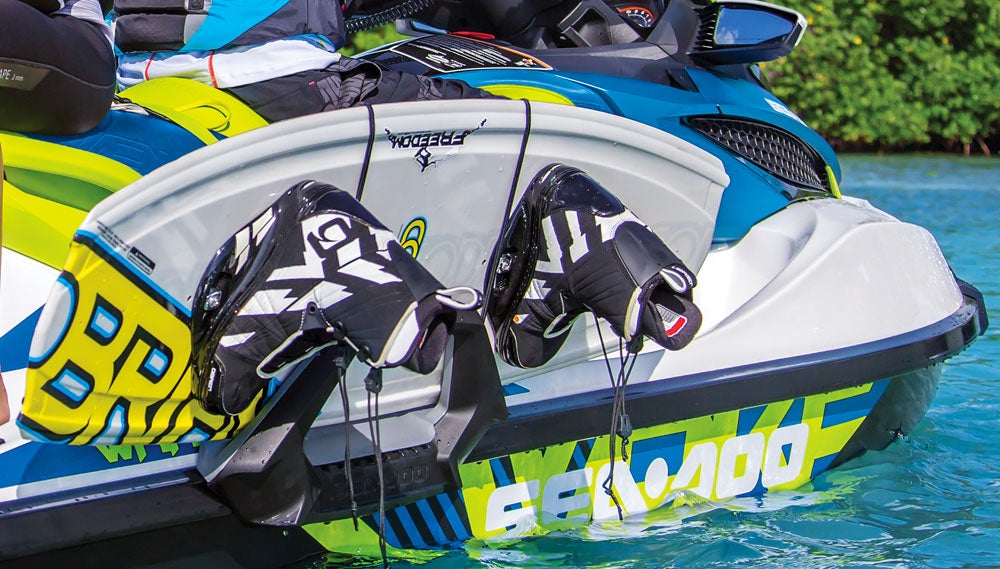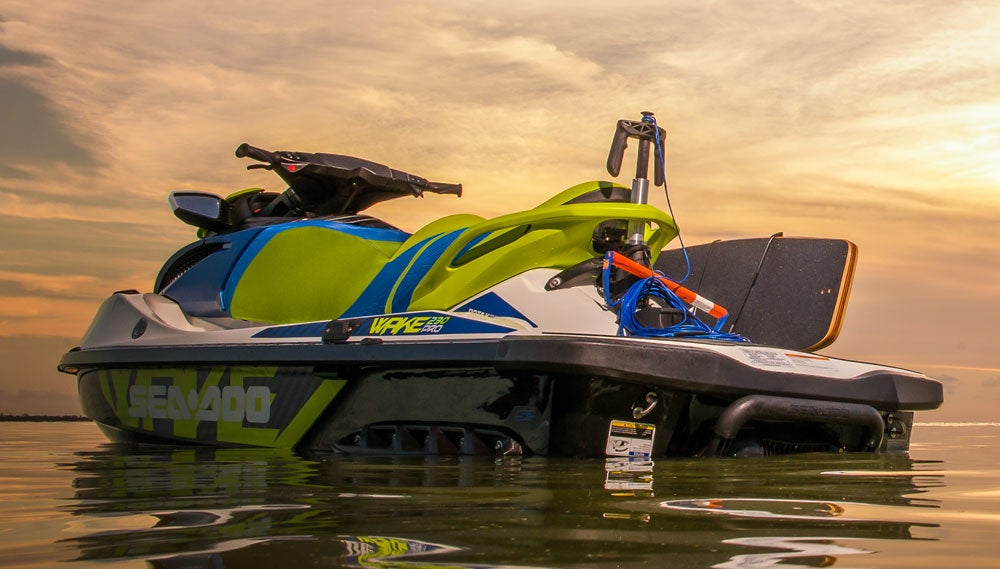2017 Sea-Doo WAKE Pro 230 Review
The PWC industry's gold standard tow vehicle
Wakesports still top the coolness charts heading into 2017, and Sea-Doo continues to be the lone manufacturer to target a specific model – or two to be precise – at this fun-loving crowd. Why choose a WAKE model over a conventional PWC, when the latter is what the craft truly is at its core? Primarily for the extras that tailor the craft to towing and the needs of wake enthusiasts. Racks, tow pylons and speed controls all combine to deliver a superior experience.
Engine: Three-cylinder 1,494cc
Fuel Capacity: 15.9 gal.
Stowage Capacity: 42.8 gal.
Seating Capacity: 3
MSRP: Starting at $14,999
The 2017 Sea-Doo WAKE Pro 230 also, however, fills a gap in the Sea-Doo lineup. With the GTX 230 only offered in a Limited configuration, the WAKE offers a craft that’s less expensive, and with a far different look for those that want the GTX hull and midrange engine, but perhaps not all the Limited trappings.
Ultimately, however, it’s mostly about the ride…the ride that happens in the saddle, as well as the ride that’s waiting in the wakes.
The WAKE Treatment
For those not familiar with the WAKE models, they add a list of extras aimed at making the craft more watersports friendly. The first addition is a rack that mounts atop the gunwale. Designed to get a wakeboard or wakeskate out of the footwells, it’s a shin saver for sure, and works easily with a basic bungee strap for security. The gunwale mount isn’t permanent, meaning you can take the rack off when you want to get aggressive without tow toys.
To that rack add a rear tow pylon. Featuring three heights, the retractable pylon doesn’t exactly get the towrope far above the water (the goal of tow towers on wake-oriented boats), but instead primarily gets it level to the rider and up and out of the jet wash. In this way it provides a more solid tow point. The pylon’s dual handles also serve as a spot for the rear-facing spotter to grab onto, providing a little added security when facing backwards.
The third major component of the WAKE system is a SKI mode added to the acceleration profiles (i.e. Touring and Sport modes). Opting into SKI mode gives you access to five additional acceleration curves, meaning you can keep things tame for kids tubing or get more low-end punch when trying to pull a solo slalom skier from deep water. The boat will also accelerate up to a predesignated speed, then maintain it cruise-control style to eliminate the fluctuations that come naturally with a human hand controlling the throttle.
Electric trim can also be used to enhance the towing experience. Raise the bow to make the most of a PWC’s small wakes, or drop it to improve those deepwater starts. The 2017 Sea-Doo WAKE PRO 230 gets the enhanced version of Sea-Doo’s trim, with two presets for quick setting changes. While not WAKE specific, the driver also benefits from the wide-angle mirrors.
What’s New?
As to that new power alluded to in the title, it’s from Sea-Doo’s switch from the former Rotax 215 to the new 1500HO ACE (Advanced Combustion Efficiency) engine. Featuring a four-valve-per-cylinder head, new combustion chamber, plasma-coated cylinders (replacing heavy cylinder sleeves), updated exhaust and intake porting, maintenance-free supercharger and more efficient intercooler, the ACE is also lighter in weight and takes up less room in the engine compartment. It also produces more power, roughly 230 horsepower, and is optimized to run on regular fuel, eliminating the extra cost of premium gasoline.
You do feel the difference. On the top end, I recorded average speeds just below 67 mph in far from ideal conditions. That’s about a two mph bump over the previous model. For wake duties you won’t likely touch that number, but for times when a rider is not in tow it’s definitely fun to have the power on tap. Sea-Doo’s standard acceleration modes remain, meaning you can have less aggressive power delivery and more fuel savings in Touring mode, or unleash the engine’s full force in Sport mode. An ECO setting lets the computer take over and map out the most fuel-efficient route.
The Missing GTX 230
As always, the WAKE models remain conventional Sea-Doo models at their core. In this case the boat in question is the GTX, meaning you get a larger, more precise handling hull and the added power of a supercharged engine. It’s fun to go fast, but that added power isn’t always ideal for towing. It can make it harder to keep a steady throttle. Away from tow duties, however, it’s got considerably more pep than the GTI-based WAKE 155. The important consideration here is probably what kind of craft you want away from towing, and how much you want to spend.
Either way, you’ll still get Sea-Doo standards like Intelligent Brake & Reverse (iBR), tilt steering, spring-loaded boarding step, digital security/speed governing lanyards, etc. On the 2017 Sea-Doo WAKE Pro 230, you’ll also get impressive storage, with 42.8 gallons of capacity.
One final selling point? As mentioned above, there’s no longer a basic GTX model offered at the midrange (230hp) engine level. The GTX 230 is only available in a Limited configuration at $14,999. Those that want the 230 engine but not the Limited extras may want to consider the 2017 Sea-Doo WAKE Pro 230 instead…even if they’re not into towing.
But come on, be into towing. It’s just so much fun.
Get PersonalWatercraft.com in your Inbox!
Like PersonalWatercraft.com on Facebook
Comments
Most Popular

2025 Yamaha JetBlaster PRO 2-Up Review

Remembering the Sea-Doo XP

2024 Kawasaki Jet Ski STX 160X Review

2017 Kawasaki Jet Ski Ultra 310LX Review

Whatever Happened to the Wetbike?


















 Your Privacy Choices
Your Privacy Choices